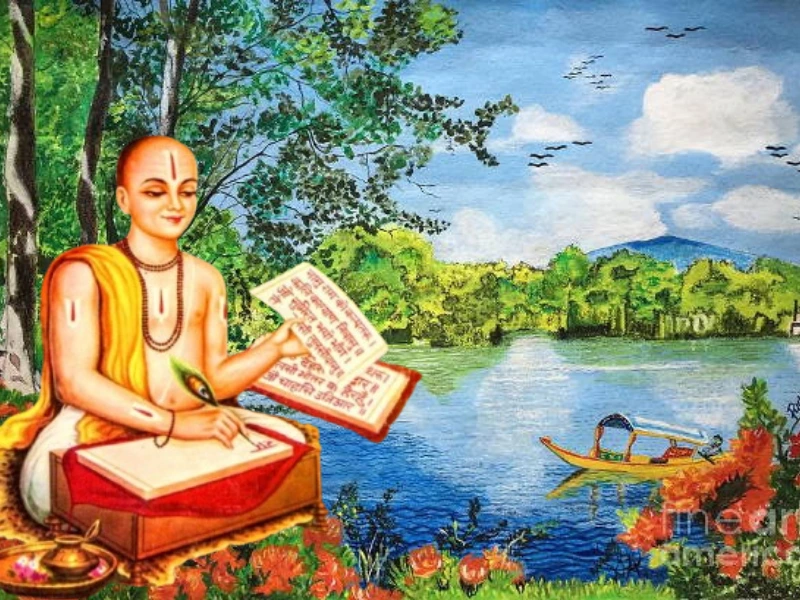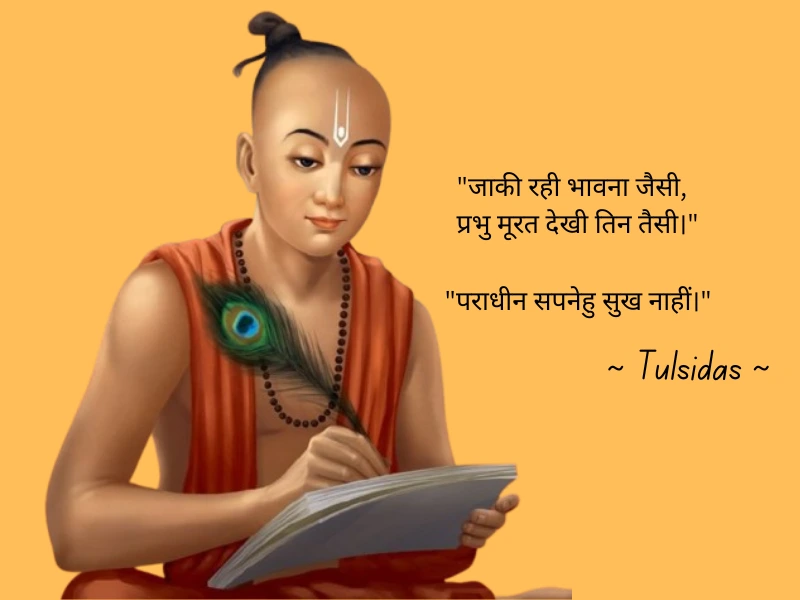Tulsidas : Life, Works, and Legacy of the Saint-Poet
Tulsidas was a saint, poet, and learned man of the 16th century. He is one of the greatest figures in the history of the spirituality of India. The very popular work of Tulsidas is the Ramcharitmanas. Tulsidas brought the story of Lord Rama before the ordinary people by composing the epic in vernacular Awadhi. His great devotion, literary talent, and spiritual writings have established him as an incomparable icon in Hindu culture. Let’s find out the inspiring journey of this great saint and his unmatched contributions.
Personal Information
- Full Name: Tulsidas (Born as Rambola)
- Date of Birth:
- The exact date is debated, but it is traditionally believed to be 1532 CE.
- He was born on the Saptami (7th day) of the Shravan month during Shukla Paksha (waxing moon phase).
- Place of Birth: Rajapur, a small village near Chitrakoot in Uttar Pradesh, India.
- Parents:
- Father: Atmaram Dubey, a Brahmin scholar.
- Mother: Hulsi.
- Wife: Ratnavali
- Education:
- Tulsidas studied in Varanasi (Kashi) under the guidance of Guru Narharidas.
- He mastered Sanskrit, Vedas, Upanishads, and Hindu scriptures.
- Language of Writings
- Awadhi (e.g., Ramcharitmanas).
- Braj (e.g., Vinay Patrika and Dohavali).
- Spiritual Guru: Narharidas, a devotee of Lord Rama, played a key role in shaping Tulsidas’s spiritual journey.
- Death: Tulsidas is believed to have passed away in 1623 CE in Varanasi, Uttar Pradesh.
Early Life of Tulsidas
Birth and Childhood
Tulsidas’s date of birth is not known with certainty, but it is believed that he was born in 1532 CE in Rajapur, a small village in Uttar Pradesh. His parents, Hulsi and Atmaram Dubey, were Brahmins. According to legend, Tulsidas was born with all 32 teeth, which was considered a sign of his divine nature. He was named Rambola because, as a newborn, he uttered the name “Rama” instead of crying.
After tragic astrological prophecies concerning his birth, his parents left him shortly after. He was looked after by Chuniya, who raised him as a child; she made sure that he stayed close to religion.
Early Education and Spiritual Inclination
Tulsidas later went to Varanasi, where he studied Sanskrit, Vedas, and other Hindu scriptures under the guidance of Guru Narharidas, a devotee of Lord Rama. It was during his time in Varanasi that he developed a deep connection with the Ramayana and began contemplating the life and virtues of Lord Rama.
Transformation and Spiritual Awakening
Turning Point in Life
Tulsidas was attracted to worldly life, and he married a woman named Ratnavali. But his attachment to her made him undergo a turning point in his life. One stormy night, he crossed the river to see his wife. She rebuked him for his attachment by saying, “If you were as attached to Lord Rama as you are to my body, you would be free from all attachments”.
These words impacted Tulsidas so much that he turned his back on worldly desires and began a spiritual journey dedicated solely to Lord Rama.
Embracing the Path of Devotion
Tulsidas became a wandering ascetic, spreading the teachings of the Ramayana and promoting devotion (Bhakti) to Lord Rama. He traveled extensively across India, visiting sacred places like Ayodhya, Chitrakoot, and Prayagraj, where he meditated and composed his literary works.
Famous Books
Tulsidas was a saint poet and devotee of Lord Rama, with some remarkable contributions to Indian literature and spirituality through his writings. His writing style is basically in Awadhi and Braj, on devotion (Bhakti), moral teachings, and glorification of Lord Rama. Some of the most famous works written by him include:
1. Ramcharitmanas
- Language: Awadhi
- Description:
Tulsidas wrote his most renowned work, Ramcharitmanas, in Awadhi, thus narrating the tale of the Ramayana in a way it was within easy reach of simple people who could not read Sanskrit. It was completed in 1574 CE and has described the life of Lord Rama with poetic beauty and spiritual depth. Often called the greatest devotional literature ever written in India.
2. Hanuman Chalisa
- Language: Awadhi
- Description:
This 40-verse devotional hymn is dedicated to Lord Hanuman. The Hanuman Chalisa is one of the most widely chanted hymns in Hinduism and is believed to invoke courage, strength, and protection.
3. Vinay Patrika
- Language: Braj
- Description:
A heartfelt collection of devotional hymns and prayers to Lord Rama, expressing humility and surrender. It reflects Tulsidas’s deep emotional connection with Lord Rama.
4. Kavitavali
- Language: Braj
- Description:
This book is a poetic exploration of Lord Rama’s life, composed in various poetic meters. It emphasizes Rama’s divine qualities and the importance of devotion.
5. Dohavali
- Language: Awadhi and Braj
- Description:
A collection of couplets (dohe) that offer moral and spiritual teachings. The Dohavali is a guide for leading a righteous and devotional life.
6. Gitavali
- Language: Braj
- Description:
A compilation of songs glorifying Lord Rama, this work focuses on his virtues and leelas (divine play). It is structured in a musical format, suitable for singing during devotional gatherings.
7. Barvai Ramayan
- Language: Braj
- Description:
This is a condensed version of the Ramayana, written in a specific poetic meter called Barvai Chhand. It summarizes the key events in Lord Rama’s life.
8. Janaki Mangal
- Language: Awadhi
- Description:
This work celebrates the marriage of Lord Rama and Sita, highlighting the divine love and union of the two. It is often recited during marriage ceremonies for blessings.
9. Parvati Mangal
- Language: Awadhi
- Description:
Similar to Janaki Mangal, this text narrates the marriage of Lord Shiva and Goddess Parvati. It reflects the divine aspect of marriage and devotion.
Themes in Tulsidas’s Work
Tulsidas’s writings focus on Bhakti (devotion) as the path to salvation, emphasizing surrender to Lord Rama. His work reflects unwavering faith in Rama’s virtues and divine grace.
By writing in vernacular languages like Awadhi, Tulsidas ensured that his teachings reached the masses. His works transcended social and linguistic barriers, promoting unity through devotion.
Legacy and Impact
Influence on Hinduism and Indian Society
Tulsidas played a vital role in the Bhakti movement, inspiring millions to embrace devotion to Lord Rama. His Ramcharitmanas became a cornerstone of Hindu spiritual practice, recited in temples and homes across India.
Global Influence of His Work
Tulsidas’s compositions, especially the Hanuman Chalisa, have gained global recognition. Even today, his works are chanted and celebrated for their spiritual wisdom and literary brilliance.
Tulsidas as a Spiritual Figure
Miracles and Stories
Many stories exist regarding Tulsidas’s life, such as the time he encountered the Lord Hanuman and the Lord Rama. There is also a legend where Tulsidas resurrected a dead Brahmin with his devotion to Hanuman.
Reverence as a Saint
Tulsidas is considered to be the incarnation of Valmiki, who first wrote the Ramayana. He is humble, devoted, and has many lessons for the saints and poets.

Tulsidas Ke Dohe
Tulsidas, the great saint-poet, is renowned for his profound and meaningful couplets (dohe) that encapsulate spiritual wisdom and moral values. Here are some of his most famous dohe with their meanings:
“जाकी रही भावना जैसी, प्रभु मूरत देखी तिन तैसी।”
Meaning:
The way a person’s feelings and beliefs are, that’s how they perceive God. God reflects our inner emotions and mindset.
“राम नाम मन देत सुख, पाप काटे सब, ताप मिटाए।
पार उतारे भव सागर, संत सदा यह गुण गाए।”
Meaning:
Chanting Lord Rama’s name brings peace to the mind, removes sins, and eradicates suffering. It helps cross the ocean of worldly existence, and saints always sing about this virtue.
“पराधीन सपनेहु सुख नाहीं।”
Meaning:
There is no happiness, even in dreams, for those who are dependent on others.
“जिन्ह कें अति प्रिय धनु धरम नाहीं।
ते नर पसु बिना पूंछ बिसाहीं।”
Meaning:
Those who do not value wealth earned through righteous means are like animals without tails and horns, unworthy of respect.
“समरथ को नहीं दोष गुसाईं।”
Meaning:
A powerful person is never blamed for their actions, regardless of what they do.
“तुलसी मीठे वचन ते सुख उपजत चहुँ ओर।
वशीकरण यह मंत्र है, तज दे वचन कठोर।”
Meaning:
Sweet words bring happiness everywhere. Speaking kindly is like a magical mantra to win hearts, while harsh words should be avoided.
“सचिव, वैद्य, गुरु तीनि जौं प्रिय बोलहिं भय आस।
राज, धर्म, तन तीनि कर होहिं बेगहि नास।”
Meaning:
If a minister, doctor, or guru speaks only to please you instead of truthfully, it will lead to the destruction of governance, health, and spirituality.
“दया धर्म का मूल है, पाप मूल अभिमान।
तुलसी दया न छोड़िए, जब लग घट में प्राण।”
Meaning:
Compassion is the foundation of righteousness, and arrogance is the root of sin. Tulsidas advises never to abandon compassion as long as you live.
Also read Kalidasa ka jivan Parichay
Conclusion
Tulsidas’s life was a testimony to the power of devotion and also the transformative nature that spirituality has on a life. It is from his works that the divine was made accessible to ordinary people, putting before people an inspiring story of Lord Rama. His legacy as a saint-poet continues to inspire millions, reminding us of the enduring power of faith and love for the divine.
Tulsidas Jayanti: Honoring the Great Saint-Poet
Tulsidas Jayanti is the birth anniversary of Goswami Tulsidas, the legendary saint-poet and author of Ramcharitmanas. It is celebrated annually on the Saptami (7th day) of the Shukla Paksha (waxing moon phase) in the Hindu month of Shravan (July-August).
Celebrations and Observances
- Recitation of Tulsidas’s Works: Devotees recite Ramcharitmanas, Hanuman Chalisa, and other compositions of Tulsidas in temples and homes.
- Special Pujas and Bhajans: Temples dedicated to Lord Rama and Hanuman organize special prayers, devotional singing, and discourses on Tulsidas’s life and teachings.
- Cultural Events: Dramas and musical performances based on the Ramayana and Tulsidas’s works are held to spread his message of devotion and righteousness.
- Reflection on Teachings: Followers use the occasion to reflect on the moral and spiritual lessons derived from his writings.
FAQs About Tulsidas
Did Tulsidas see Hanuman?
Yes, according to legends, Tulsidas had divine encounters with Hanuman, who guided him and blessed his spiritual journey.
What is the most famous work of Tulsidas?
Tulsidas’s most famous work is the Ramcharitmanas, a poetic retelling of the Ramayana in the Awadhi language.
Did Tulsidas write the Ramayana?
Tulsidas did not write the original Ramayana, which was authored by Sage Valmiki. However, he wrote the Ramcharitmanas, a widely celebrated version of the Ramayana.
How many teeth did Tulsidas have?
Tulsidas was born with all 32 teeth intact, a phenomenon considered a sign of his divine nature.



